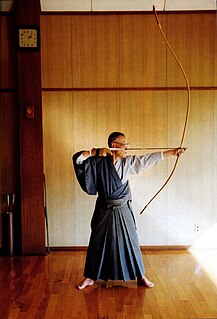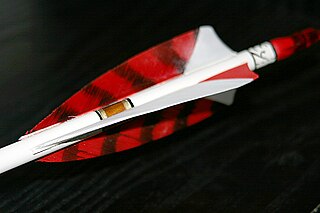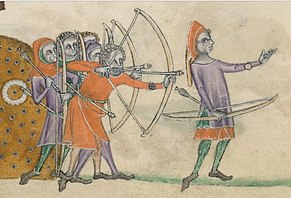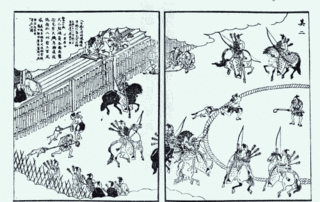
Archery is the sport, practice, or skill of using a bow to shoot arrows. The word comes from the Latin arcus, meaning bow. Historically, archery has been used for hunting and combat. In modern times, it is mainly a competitive sport and recreational activity. A person who practices archery is typically called an archer, bowman, or toxophilite.

A quiver is a container for holding arrows, bolts, ammo, projectiles, darts, or javelins. It can be carried on an archer's body, the bow, or the ground, depending on the type of shooting and the archer's personal preference. Quivers were traditionally made of leather, wood, furs, and other natural materials, but are now often made of metal or plastic.

Kyūdō is the Japanese martial art of archery. High level experts in kyūdō may be referred to as kyūdōka (弓道家), and some practitioners may refer to themselves as yumihiki (弓引き), or 'bow puller'. Kyūdō is based on kyūjutsu, which originated with the samurai class of feudal Japan. Kyūdō is practised by thousands of people worldwide. As of 2005, the International Kyudo Federation had 132,760 graded members.

Ishi was the last known member of the Native American Yahi people from the present-day state of California in the United States. The rest of the Yahi were killed in the California genocide in the 19th century. Ishi, who was widely acclaimed as the "last wild Indian" in the United States, lived most of his life isolated from modern North American culture. In 1911, aged 50, he emerged at a barn and corral, 2 mi (3.2 km) from downtown Oroville, California.

The bow and arrow is a ranged weapon system consisting of an elastic launching device (bow) and long-shafted projectiles (arrows). Humans used bows and arrows for hunting and aggression long before recorded history, and the practice was common to many prehistoric cultures. They were important weapons of war from ancient history until the early modern period, where they were rendered increasingly obsolete by the development of the more powerful and accurate firearms. Today, bows and arrows are mostly used for hunting and sports.

Yabusame (流鏑馬) is a type of mounted archery in traditional Japanese archery. An archer on a running horse shoots three special "turnip-headed" arrows successively at three wooden targets.

A composite bow is a traditional bow made from horn, wood, and sinew laminated together, a form of laminated bow. The horn is on the belly, facing the archer, and sinew on the outer side of a wooden core. When the bow is drawn, the sinew and horn store more energy than wood for the same length of bow. The strength can be made similar to that of all-wood "self" bows, with similar draw-length and therefore a similar amount of energy delivered to the arrow from a much shorter bow. However, making a composite bow requires more varieties of material than a self bow, its construction takes much more time, and the finished bow is more sensitive to moisture.

Fletching is the fin-shaped aerodynamic stabilization device attached on arrows, bolts, darts, or javelins, and are typically made from light semi-flexible materials such as feathers or bark. Each piece of such fin is a fletch, also known as a flight or feather. A fletcher is a person who attaches fletchings to the shaft of arrows.

Fred Bear was an American bow hunter, bow manufacturer, author, and television host.

A thumb ring is a piece of equipment designed to protect the thumb during archery. This is a ring of leather, stone, horn, wood, bone, antler, ivory, metal, ceramics, plastic, or glass which fits over the end of the thumb, coming to rest at the outer edge of the outer joint. Typically a flat area extends from the ring to protect the pad of the thumb from the bowstring; this may be supplemented by a leather extension.

Archery, or the use of bow and arrows, was probably developed in Africa by the later Middle Stone Age. It is documented as part of warfare and hunting from the classical period until the late medieval period when it was made obsolete by the increased use of firearms.

The Yankton Sioux Tribe of South Dakota is a federally recognized tribe of Yankton Western Dakota people, located in South Dakota. Their Dakota name is Ihaƞktoƞwaƞ Dakota Oyate, meaning "People of the End Village" which comes from the period when the tribe lived at the end of Spirit Lake just north of Mille Lacs Lake. The CNWRR records state the name is alternately spelled with an "E" instead of an "I" or "Ehanktowan".

A horse archer is a cavalryman armed with a bow and able to shoot while riding from horseback. Archery has occasionally been used from the backs of other riding animals. In large open areas, it was a highly successful technique for hunting, for protecting the herds, and for war. It was a defining characteristic of the Eurasian nomads during antiquity and the medieval period, as well as the Iranian peoples, and Indians in antiquity, and by the Hungarians, Mongols, Chinese, and the Turkic peoples during the Middle Ages. By the expansion of these peoples, the practice also spread to Eastern Europe, Mesopotamia, and East Asia. In East Asia, horse archery came to be particularly honored in the samurai tradition of Japan, where horse archery is called Yabusame.

The Witchery of Archery, written by Maurice Thompson in 1878, was the first book in English about hunting with a bow ever published. Its full title is The Witchery of Archery: A Complete Manual of Archery. With Many Chapters of Adventures by Field and Flood, and an Appendix Containing Practical Directions for the Manufacture and Use of Archery Implements. It was the first important book about archery written in English since Toxophilus, which was written in 1545. It was said that Witchery "...has as much effect on archery as Uncle Tom's Cabin had on the Civil War.

Henry Balfour FRS FRAI was a British archaeologist, and the first curator of the Pitt Rivers Museum.

Archery in Bhutan is the national sport of the Kingdom. Archery was declared the national sport in 1971, when Bhutan became a member of the United Nations. Since then, the popularity of Bhutanese archery has increased both inside and outside Bhutan, with a measure of government promotion. Bhutan also maintains an Olympic archery team. Previously, competitions were held only at dzongkhag and gewog levels, however modernly, archery tournaments and competitions are held throughout the country. Archery is played during religious and secular public holidays in Bhutan, local festivals (tsechu), between public ministries and departments, and between the dzonkhag and the regional teams. Archery tournaments and performances have also become a significant point of interest for tourism in Bhutan.
Sports in Bhutan comprise both traditional Bhutanese and modern international games. Archery is the national sport in Bhutan. Competitions are held regularly in most villages. Other traditional Bhutanese sports include khuru, soksom, pundo and digor.

Inuoumono (犬追物) was a Japanese sport that involved mounted archers shooting at dogs. The dogs were released into a circular enclosure approximately 15m across, and mounted archers would fire upon them whilst riding around the perimeter.
Arab archery is the traditional style of archery practiced by the Arab peoples of the Middle East and North Africa from ancient to modern times.
Traditional Eskimo hunters lack the more elastic timbers used to make bows in temperate and tropical parts of the world. Using sinew cords for the back of the bow, and spruce timber or antler for the belly, however, they build very effective weapons. When hunting polar bears, the bows used are powerful enough, if they do not hit bone, to penetrate completely through the body of the bear.
















